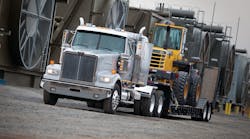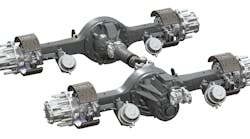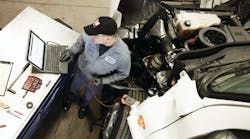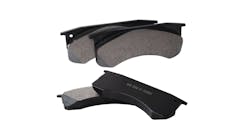One key drivetrain component is the driveline, which is often overlooked but critical to vehicle performance. Drivelines in one way are simple components, yet they are complex in terms of optimum performance and vehicle reliability. While it often goes largely unnoticed, the driveline is vital to vehicle uptime and operation.
Lubed for life drivelines can be an ideal specification for reduced maintenance, long life and strong performance. The U-joint and slip shaft are lubed and sealed at the factory.
Meritor (www.meritor.com) - a leading global supplier of drivetrain, mobility, braking and aftermarket solutions for commercial vehicle and industrial markets - has located many drivelines in customers' operations with in excess of one million miles. According to Tom Sanko, product manager-drivelines, Meritor, fleet management is pleasantly surprised to see the limited amount of wear on these million mile joints and several fleets not currently specifying Meritor's Permalube RPL permanently lubricated drivelines have adjusted their specs to include that driveline as a result of these real-life reviews.
"We have customers' drivelines (RPLs) purposely brought back to our Troy headquarters that are in excellent condition after as many as 1.6 million miles," he says.
ESSENTIALS FOR LONG DRIVELINE LIFE
Sanko says the keys to even greater vehicle efficiency and long driveline life include:
- Spec for proper vocation. Too many stock vehicles are sold into vocations for which the truck or tractor was not specified for.
- Use Meritor's published Driveline Application Guidelines (TP-12126) to properly size the driveline for optimal performance and reliability. Several factors such as vocation, weight, horsepower, torque, tire size and axle ratio have a great influence on the minimum required driveline sizing. (This publication can be found in Fleet Maintenance's online Media Center at www.vehicleservicepros.com/media-center/whitepaper.)
- Spec "no maintenance" for longest life, "but we all know that there's no such thing as 'no maintenance' and even 'reduced maintenance' requires inspections to ensure components are performing without issue and within engineering tolerances," notes Sanko. "(The) highest quality components and lube, along with larger lube capacity, will last the longest.
- Zerk fittings also can lose lubricant if contamination holds open the inlet check ball, causing lube loss and premature U-joint failure. Furthermore, "in lube type versions, too many technicians do not clean the zerk fittings before greasing, allowing debris to be pushed into the U-joint, which can contribute to higher wear," says Sanko.
"The best way to reduce driveline maintenance is to spec one that requires no lubrication," he recommends.
"The obvious choice is to spec a permanently lubricated driveline - in the case of Meritor, it's the RPL," Sanko adds. "Being greased and sealed by Meritor, it has no provision for adding lube over its entire lifetime.
"Although greasing is not possible, inspection for any damage is strongly recommended during regular maintenance intervals. It still requires inspections, but essentially no greasing intervals are required.
"For most line haul applications that can mean at least four to five years of labor and grease savings."
GREASE INTERVALS
It's an industry phenomenon that if the product has a grease fitting on it, it will get greased during every maintenance cycle, whether every 25,000 miles, 30,000 miles or even every month, Sanko observes. It takes more effort to maintain the records of whether to grease or not than to simply grease it whenever the truck is in the shop.
An extended lube feature, like on the Meritor Xtended Lube MXL Drivelines with 100,000-mile lube intervals, offers a degree of "insurance" against a lube cycle being skipped inadvertently, he points out.
Specific RPL design characteristics include non-booted design for the slip section sealing, an integral cup-to-yoke design which simplifies and enhances that connection (which eliminates the "spinning cup") and extends the life of the end-yoke and u-joint.
NEW DRIVELINE INITIATIVES
"With the never ending quest for improved fuel economy," says Bob Ostrander, chief engineer-drivelines, Meritor, "fleets are specifying direct drive transmissions and automated mechanical transmissions with very fast axle ratios to reduce engine rpm while maintaining desired highway speeds. The trade-off with this approach is that a lower driveline rpm must transmit considerably higher torque for the same horsepower so larger drivelines are required to handle the torque and exhibit the same life expectancy."
Company executives explained that ongoing considerations to raise federal weight limits on trucks (up to 97,000 lbs for trucks equipped with six axles instead of the typical five), as well as to reduce overall vehicle weight, along with the rising needs of the medium duty segment, are all factors behind several new driveline initiatives it is launching.
For starters, the Meritor plans to expand its Permalube (RPL) series driveline family by adding a new model, RPL 3X, designed for trucks hauling increased gross combination weights of 97,000 lbs or more, complete with faster ratios.
The company continues to investigate different lightweight options for future drivelines, including various alternative materials and designs. Its goals include saving weight, assuring a payback and making sure to address performance, serviceability and reliability.





